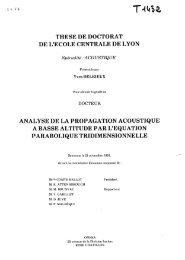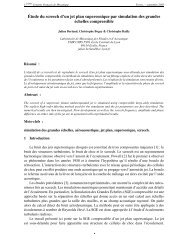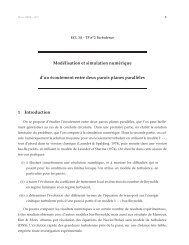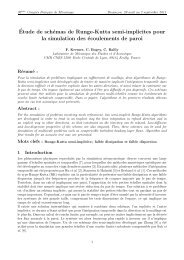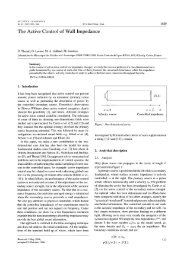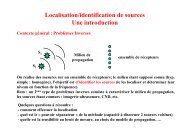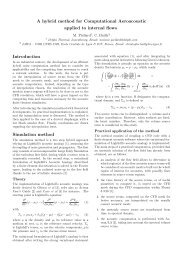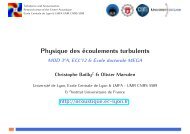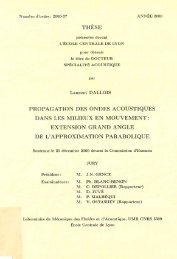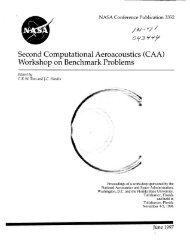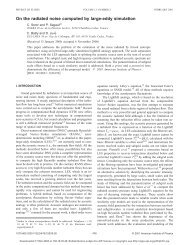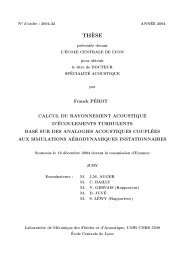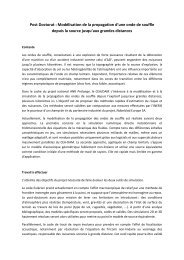ERCOFTAC Bulletin - Centre Acoustique
ERCOFTAC Bulletin - Centre Acoustique
ERCOFTAC Bulletin - Centre Acoustique
Create successful ePaper yourself
Turn your PDF publications into a flip-book with our unique Google optimized e-Paper software.
20log10(Jm(kD/2sintheta)/Jm(kD/2sintheta)), dB<br />
10<br />
0<br />
-10<br />
-20<br />
-30<br />
-40<br />
-50<br />
0 1 2 3 4 5<br />
(m)<br />
St=0.2<br />
St=0.5<br />
St=0.8<br />
St=1.1<br />
Figure 1: Relative efficiencies of azimuthal mode m compared<br />
to the axisymmetric case, considering θ = 30 ◦ ,<br />
M = 0.9 and r = D/2.<br />
expect considerable sound radiation from structures in<br />
the flow with significant azimuthal coherence. For higher<br />
frequencies the differences become gradually lower, and<br />
m = 0 and 1 have similar efficiencies at a Strouhal number<br />
around 1. For lower Mach numbers, the dominance of<br />
mode 0 is accentuated, as seen in Figure (2) for M = 0.6.<br />
20log10(Jm(kD/2sintheta)/Jm(kD/2sintheta)), dB<br />
10<br />
0<br />
-10<br />
-20<br />
-30<br />
-40<br />
-50<br />
0 1 2 3 4 5<br />
(m)<br />
St=0.2<br />
St=0.5<br />
St=0.8<br />
St=1.1<br />
Figure 2: Relative efficiencies of azimuthal mode m compared<br />
to the axisymmetric case, considering θ = 30 ◦ ,<br />
M = 0.6 and r = D/2.<br />
If we are interested at the peak directions and frequencies<br />
for subsonic jet noise, which correspond to low angles<br />
and low Strouhal numbers, we can thus concentrate on<br />
the axisymmetric mode. Moreover, if kr sin θ ≪ 1, we<br />
can make a further approximation by taking J0(kr sin θ)<br />
to be 1, and the axisymmetric source is equivalent to a<br />
line distribution of quadrupoles. The far-field pressure is<br />
given by<br />
<br />
×<br />
p(x, m = 0, ω) = − k2 cos 2 θe −ikx<br />
e −ikz cos θ dz<br />
<br />
2x<br />
T11(z, r, m = 0, ω)rdr. (3)<br />
A further interesting result is given by Crow[10, 7],<br />
who assumed a line distribution consisting of a hydrodynamic<br />
wave with an envelope given by a Gaussian,<br />
<br />
T11(z, r, m, ω)rdr = 2ρUũe −ikHz e − z2<br />
L 2 , (4)<br />
to model the amplification, saturation and decay of an instability<br />
wave (or wavepacket). For this model the sound<br />
radiation is given by<br />
p(x, m = 0, ω) = − ρ0UũM 2 c (kHD) 2L √ π cos2 θ<br />
e<br />
8x<br />
−ikx<br />
×e − L2k 2<br />
(1−Mc cos θ)2<br />
H<br />
4 . (5)<br />
The exponential dependence of the sound field on θ,<br />
present in Eq. (5), has been labelled superdirectivity[9, 6].<br />
This dependence is significant if the axial extent of the<br />
wavepacket, which is related to L, is comparable to the<br />
acoustic wavelength.<br />
This is in contrast with the results for compact sources.<br />
A compact eddy has a directivity (for the pressure field)<br />
given by the factors cos 2 θ, sin 2 θ or sin θ cos θ depending<br />
on the orientation of the quadrupole axes. The superdirective<br />
field of Eq. (5) is due to the interference in<br />
an extensive source between the regions of positive and<br />
negative sign.<br />
The theoretical results presented so far show that if<br />
such axisymmetric wavepackets, with a high axial extent,<br />
are present in a jet, we should expect to measure such<br />
superdirectivity in the acoustic field. The next section<br />
presents an experimental investigation of this issue.<br />
3 Experimental observations in<br />
the acoustic field<br />
The decomposition of the experimental acoustic field into<br />
azimuthal Fourier modes can be done either by performing<br />
correlations[15, 20] or by using a microphone array[2],<br />
and, in a linear context such as any linearised acoustic<br />
analogy, we can expect that the lower azimuthal modes<br />
will correspond to sound radiation by structures with<br />
high azimuthal coherence.<br />
The cited studies[15, 20, 2] have shown that only a<br />
small number of azimuthal modes are present in the<br />
acoustic field. This is also the case for the near pressure<br />
field[37]. Figure (3) reproduces results from Cavalieri et<br />
al.[6]. The results show that most of the sound radiation<br />
at low axial angles is axisymmetric, the higher modes<br />
having lower contributions to the OASPL.<br />
OASPL (dB)<br />
100<br />
95<br />
90<br />
85<br />
Total<br />
Mode 0<br />
Mode 1<br />
Mode 2<br />
80<br />
20 30 40 50 60 70 80 90<br />
theta (deg)<br />
Figure 3: Directivity for a M = 0.6 jet.<br />
<strong>ERCOFTAC</strong> <strong>Bulletin</strong> 90 35



